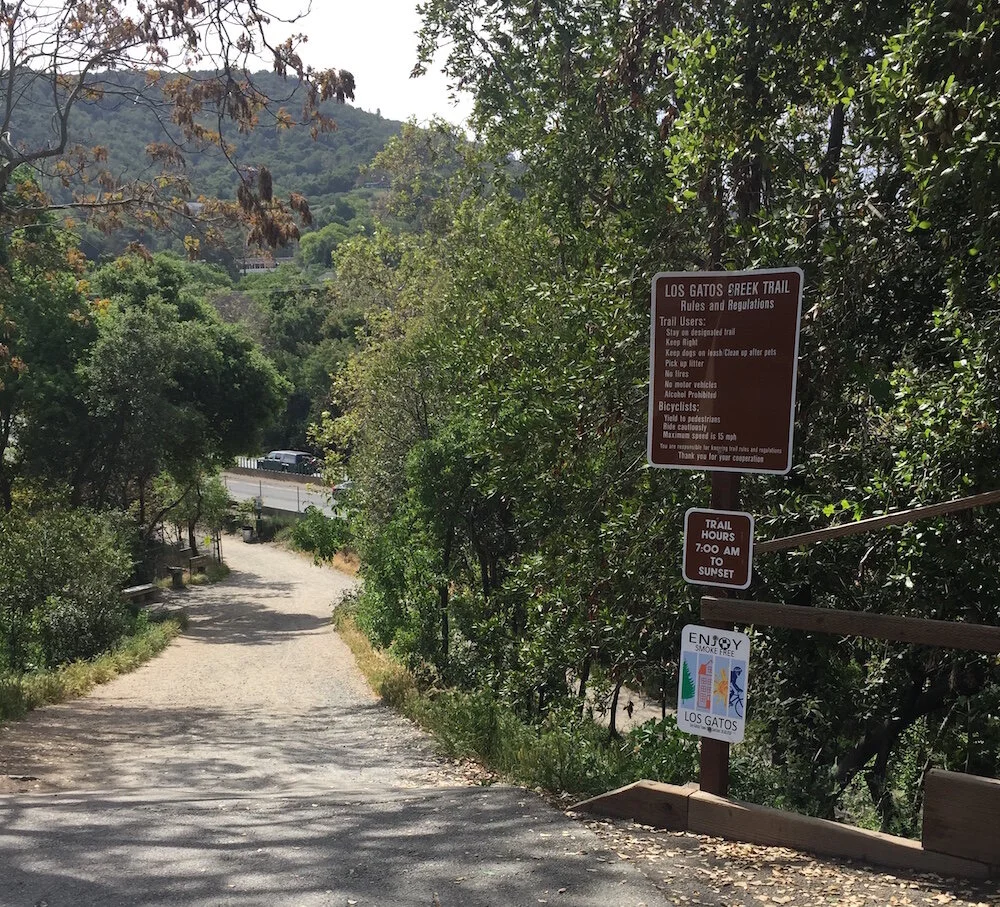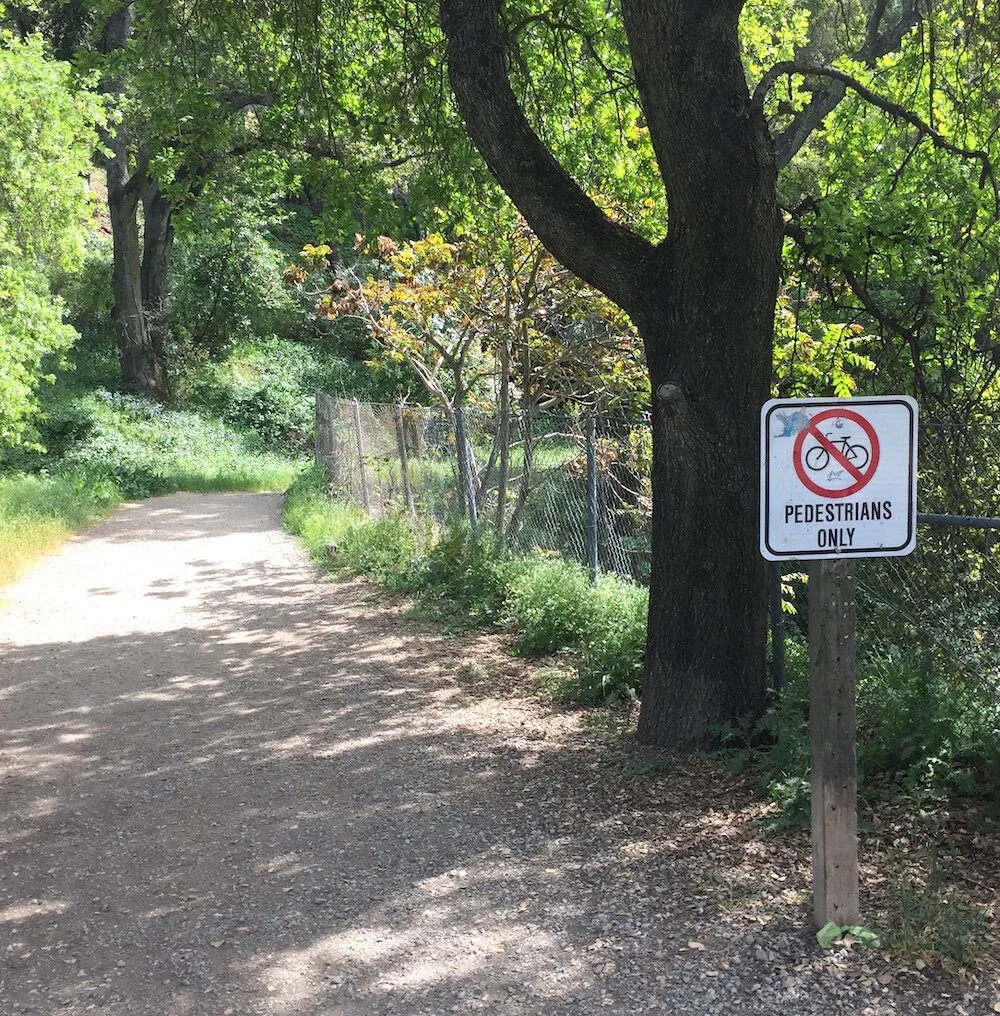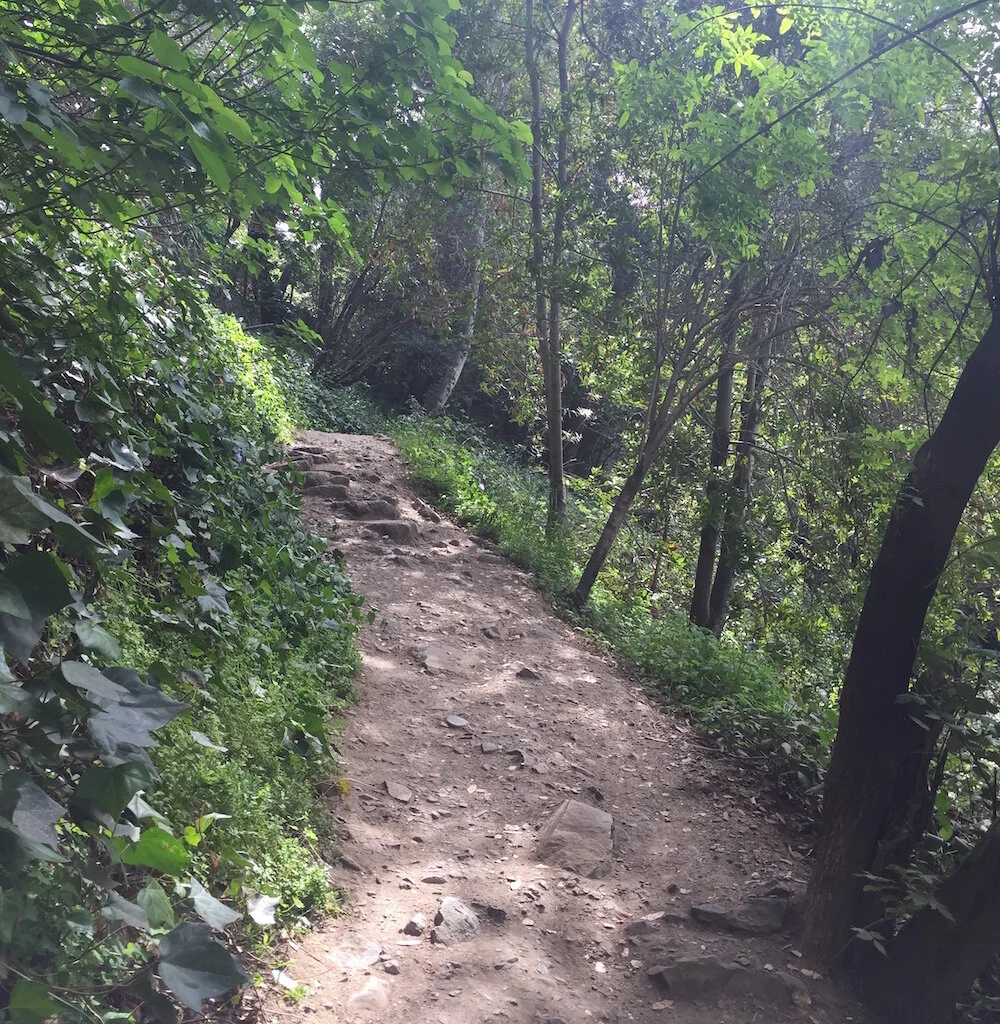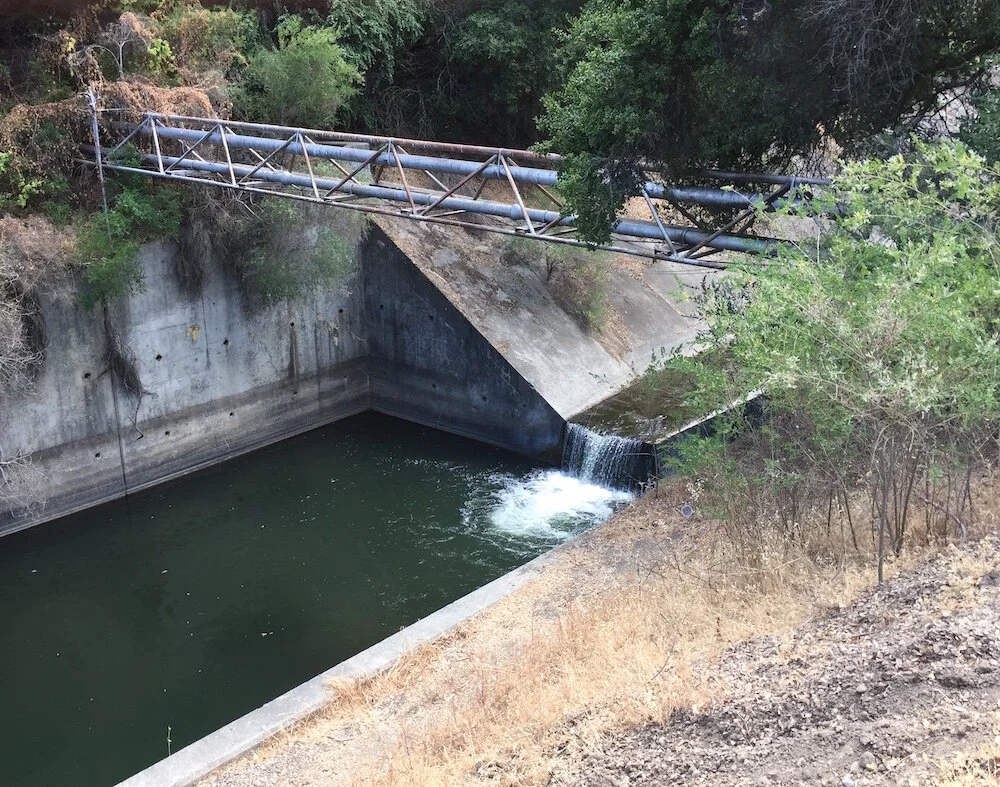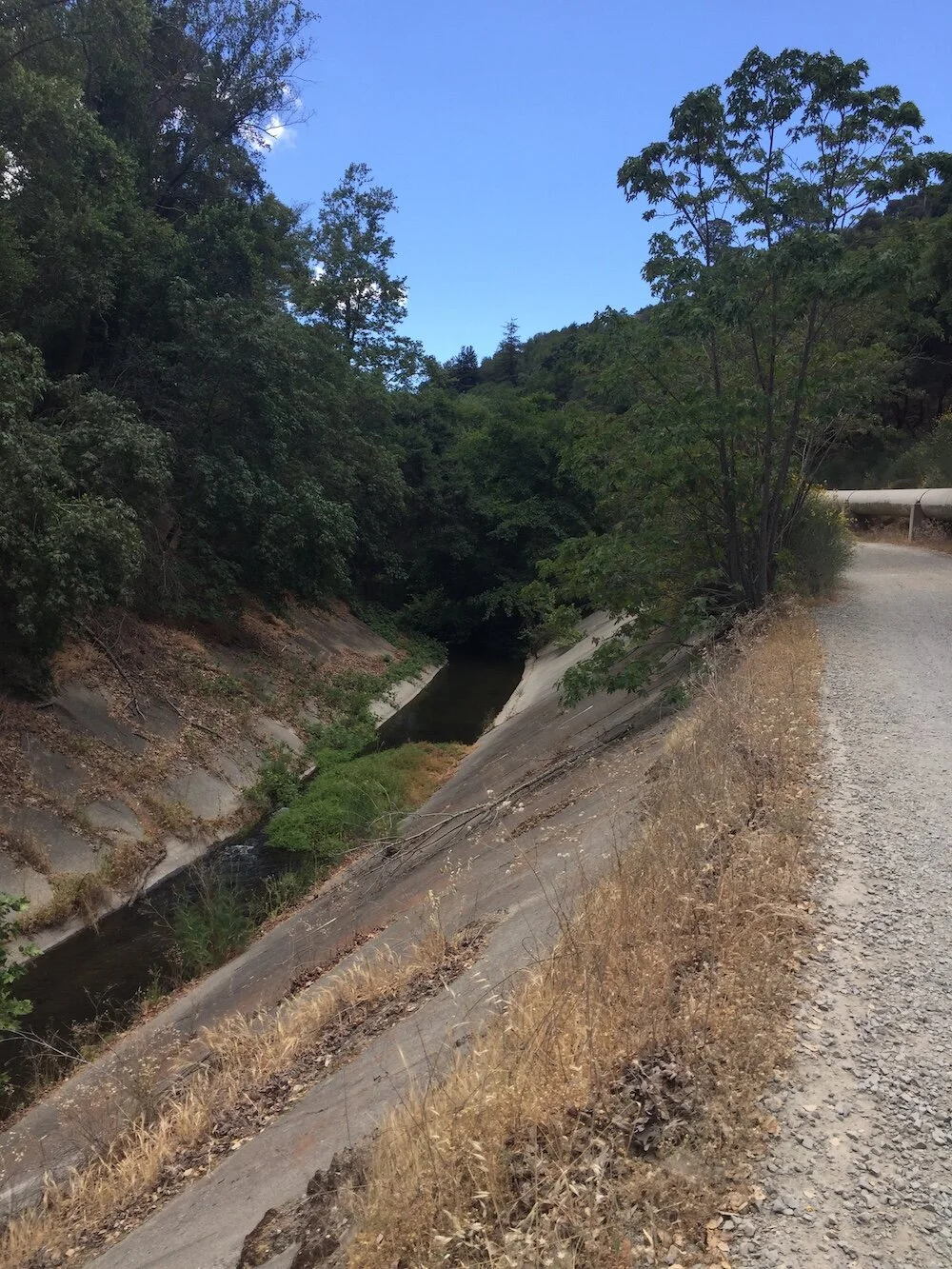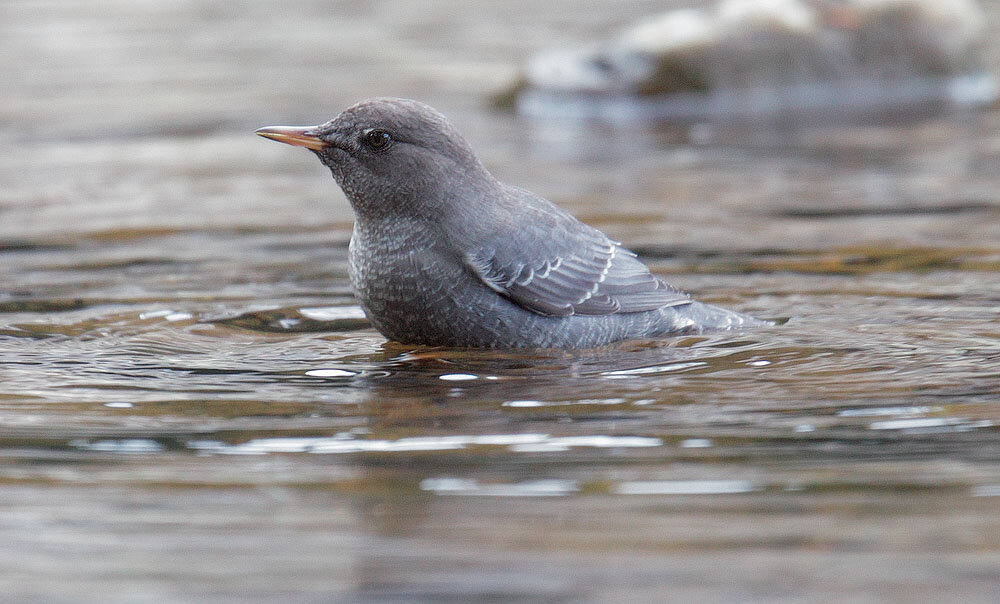Los Gatos Creek Trail South of Main (Year-round):
American Dippers
by Lisa Myers
Visit the Los Gatos Creek Trail south of East Main Street in Los Gatos to find the American Dipper, America’s only aquatic songbird. Watch these birds walk, wade, swim and even dive in and out of the water as they hunt for food.
Trip Covers: Year-round
Key Birds: Anna’s Hummingbird, Acorn Woodpecker, Nuttall’s Woodpecker, Steller’s Jay, California Scrub-Jay, Chestnut-backed Chickadee, Oak Titmouse, swallows depending on the season, Bushtit, American Dipper, Lesser Goldfinch, Dark-eyed Junco, California Towhee, Spotted Towhees and various other sparrows
How To Bird
For this self-guided birding trip we are going to focus on one target species, the American Dipper. American Dippers are a unique songbird in that they specialize in eating aquatic insects and their larvae that they catch above and under the water, thus making them America’s only aquatic songbird. American Dippers also eat mayflies, mosquitoes, small fish, worms, dragonflies and other flying insects. We usually find them on fast flowing, unpolluted mountain streams throughout the west from Central America to Alaska. Fortunately for us, the water that flows out of Lexington Reservoir into Los Gatos Creek provides the habitat this water-loving songbird requires.
The Los Gatos Creek Trail runs for many miles along Los Gatos Creek, however the closest entrance to where the American Dippers have been found is off E. Main Street in Los Gatos (trailhead on Interactive Map). There are signs to direct you to the trail as you walk in from the east side of the Main Street Bridge.
Los Gatos Creek Trailhead on East Main Street
From the street, the cemented path quickly changes to dirt as it drops you down to the Los Gatos Creek Trail. At the bottom of the hill you’ll want to go south (towards Lexington Reservoir) but you have two options. If you take the left fork, the trail name changes to the Flume Trail, which takes you along the east side of the creek (#1 on Interactive Map).
Start of the Flume Trail. Los Gatos Creek will be on your right.
There are no bikes allowed, however the trail narrows and there are some rocky and steep areas to maneuver. The Flume Trail takes you along the hillside with vegetation on both sides. This trail allows you to look for a variety of birds within the riparian tree cover as you work your way toward the stretch of creek the dippers prefer.
The Flume Trail can be rocky
Bench along the Flume Trail
For the ease in getting you to where the dippers can be found we will take the split to the right which is the Los Gatos Creek Trail (#2 on map). The trail is flat and easier to walk, but you will have to share the trail with more people including bikes. You are also walking parallel to Highway 17 and there is no escaping the sounds of the northbound traffic. As you walk southbound (towards Lexington Reservoir) you will find thick vegetation between the trail and the creek. The overgrown vegetation here is a good place to look for Steller’s Jays, Chestnut-backed Chickadees, and a variety of songbirds in addition to any ducks or herons that might be hidden down near the creek.
Los Gatos Creek Trail along Hwy 17
You do not have to walk very far before the vegetation on each side of the creek starts to clear exposing the steep concrete which lines the waterway. Look for your first little waterfall (#3 on map).
The first waterfall along creek where you should start looking for American Dippers
This is the area of the creek you should start looking for American Dippers. These songbirds do not sit in trees, they are always found on the waters edge or in the water. So you have to look down into the creek. Look for bright white dipper droppings on the cement lined creek or on top of any rocks exposed above the water. This will be a clue that dippers have recently been near. These all grey, short tailed, plump birds are about the size of an American Robin. They can be hard to spot as their slate grey coloration camouflages them against the wet, rocky habitats where they live and feed.
The slate grey coloration of the American Dipper camouflages them against wet, rocky habitats. Photo by Brooke Miller taken along this section of Los Gatos Creek.
For the Los Gatos Creek dippers look for movement down by the water’s edge where they can be found perched or hunting. Keep in mind that American Dippers are almost always bobbing. They act fearless even with people in view and you can watch them walk, wade, swim and even dive in and out of the water as they hunt for food.
American Dipper foraging for food by Tom Grey taken at 4,000 feet elevation in the Sierras
While observing an American dipper you may notice a white flash every time it blinks. What you are seeing is the eye lid which is covered in tiny, white feathers. With each blink comes the white flash. No one knows why their eye lids are so flashy. Some believe it may allow dippers to communicate to each other above the roar of a raging river, but no one knows for sure. This feathered eyelid is in addition to the nictitating membrane; a translucent eye covering that protects the eye when birds are hunting, flying or fishing while still allowing a bird to see.
American Dipper blinking. No one knows exactly why, but the eye lids of American Dippers are covered in tiny, white feathers. Photo by Brooks Miller taken along this section of Los Gatos Creek. Photo by Brooke Miller taken along this section of Los Gatos Creek.
As you continue, you’ll soon get a long view down the creek and the dippers can be found along this entire stretch. While you can continue down the trail all the way to Lexington Reservoir, when it comes to looking for dippers, this is the area where we turn around (#4 on map). It is roughly ¼ of a mile from Main Street Bridge before you hit this section of the creek that disappears into the vegetation.
Los Gatos Creek Trail looking south. American Dippers can be found along this entire stretch of the creek.
Los Gatos Creek disappearing into the vegetation. If you are looking for the dippers, this is the turn-around point.
As you head back, continue to scan the water for movement and listen for the dipper’s “zeeet” call. They also have a crisp, clear song that they repeat. It may be hard to hear over the traffic noise, but if you can, it will help you locate the bird. You should also look for birds possibly flying up and down the creek. Look for a grey flash as they fly fast and in a straight line just above the water.
American Dippers build their nests, made of moss and plant materials, out of view on inaccessible ledges. This could include under a man-made bridge, between boulders, behind waterfalls or on a cliff edge next to fast moving water. Observing the adult birds taking food or vegetation back and forth to one area may indicate a nest location. They will reuse a nest site year after year.
American Dipper with nesting material by Brooke Miller taken along this section of Los Gatos Creek
American Dippers are solitary most of the year, but during the breeding season pairs become (for the most part) monogamous. The female incubates 4-5 eggs for 13 – 17 days. Once hatched both parents feed the nestlings who will fledge 18 – 26 days later. They leave the nest able to swim and dive for their food. Juvenile birds have a pale bill and belly and fine scalloping to their feathers.
Juvenile American Dipper with pale bill and belly and fine scalloping on their feathers by Tom Grey taken at 4,000 feet elevation in the Sierras.
When scanning the creek below there is always a chance that a Belted Kingfisher will fly through. During the spring be on the lookout for various species of swallows that nest and hunt along the creek. If you look up from the trail and west in the skies above the Santa Cruz Mountains you may spot Red-tailed Hawks, Band-tailed Pigeons or a teetering Turkey Vulture.
Historic American Dipper Data by Bill Bousman
James Cooper collected an American Dipper in 1863 along Arroyo Quito which is now known as Saratoga Creek. Cooper also wrote - “I first met with this plainly colored, but very interesting bird, at a mountain stream in the Coast Ranges west of Santa Clara, where there was a pair apparently mated, as early as March 10th….In May I found the nest of another pair along a stream a few miles farther south, the ‘Arroyo de los Gatos.’ It was built near the foot of a milldam, and rested on a slight ledge under an overhanging rock, from the top of which water was continually dripping.” [p. 26] {Cooper, J. G. 1870. Ornithology, Volume I, Land Birds. Geological Survey of California (S. F. Baird, editor)}
American Dippers can be found in the Santa Cruz Mountains and along Stevens Creek above the reservoir. American Dippers along this section of Los Gatos Creek were recorded: 5/18/05; Los Gatos Creek, SCL (Lisa Myers); not far from Main Street in cemented section with clear views from Los Gatos Creek Trail.
Ready for More?
The Los Gatos Creek Trail continues south all the way to Lexington Dam. The Flume Trail continues into St. Joseph’s Hill Open Space Preserve. Also consider birding at Vasona Lake County Park just north and also along Los Gatos Creek. It’s an urban park with riparian woodlands, a small lake, eucalyptus groves, large shady manicured lawns and lots of picnic tables.
Interactive Map
Directions
Coming southbound on Highway 17, exit East 20 E at highway 9 (Los Gatos Saratoga Road) and follow to Los Gatos Blvd. Turn right. Los Gatos Blvd turns into E. Main Street as it takes you toward downtown. You will eventually come to the Main Street Bridge as it crosses over Highway 17. Turn left onto Park Ave. where you will find public parking.
Coming from Santa Cruz heading northbound, you exit onto South Santa Cruz Blvd. And follow to W. Main Street and turn right. From Main Street you’ll turn right onto Park Ave. The public parking lot is on your left. From here you’ll walk back out to Main street and turn right to cross over highway 17 to get to the trail entrance.
Parking: Parallel parking is an option along E. Main Street Latitude/Longitude: 37.221554, -121.981904. There is also a free, public parking lot west of the Main Street on Park Ave Latitude/Longitude: 37.221367, -121.982927. Turn south onto Park Ave. From the lot it's an easy walk over highway 17, across the Main Street Bridge and to the trail entrance.
Fees: There are no fees to access the trail.
Public Transportation: VTA Bus Stop at Main St and Church St, 0.1 mile walk from bus stop.
Park Hours: 7 am until sunset
Facilities: Once you drop down from E. Main Street onto the trail there will be no facilities.
Trip Mileage: The Los Gatos Creek Trail covers many miles, but the distance between the Main Street bridge and where the dippers can be seen is just under 1/4 of a mile.
Trail Conditions: This section of the Los Gatos Creek trail is loose dirt with pebbles and gravel.
Accessibility: There are many places one can access the Los Gatos Creek Trail, however the path down to the trail off of E. Main Street is rather steep and not a good way to go if using a wheelchair. The Los Gatos Creek Trail is also dirt along this section which also makes it difficult via wheelchair.
Bikes: Bikes are allowed on the trail along the west side of the creek. Bikes are not allowed if you use the Flume Trail on the east side of the creek.
Dogs: Dogs are allowed on leash.
More Information
eBird hotspot: Los Gatos Creek Trail--south of Main St.
All About Birds: American Dipper
More Resources
For more trips like this one, visit Self-Guided Field Trips.
Visit the SCVAS Birding Resources page for more information on where to bird, our birding community, bird identification resources and more.
Read “What to Look for Now” by SCVAS Executive Director Matthew Dodder.
Photo Credits: All photos by Lisa Myers unless otherwise stated.
Banner Photo Credit: American Dipper by Brooke Miller taken along this section of Los Gatos Creek.
Last Updated: 5/18/2022
Enjoyed this Trip?
Support the work of Santa Clara Valley Bird Alliance and become a member. To contact the trip writer with comments, questions or location updates, please email fieldtrips@scvbirdalliance.org. You can also post in the comment section below. (If you’d like to post anonymously, type your comment, select “Post Comment”, then simply provide a name, like “Guest”, and select “Comment as Guest”.)


